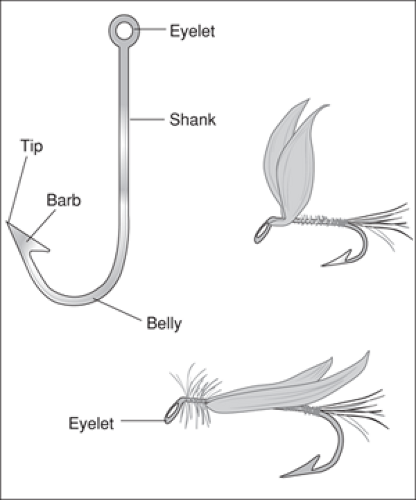Fishhook Removal
Douglas S. Diekema
Introduction
Removal of a fishhook can pose a challenge to those working in the emergency department (ED). Most frequently the hook will find its way into a finger or foot. The barb on the end of the hook prevents easy removal, but several time-honored techniques provide effective means of extraction. No clinical trial has compared the most common methods, although all have been the subject of colorful discussion in letters to the editor of various medical journals (1,2,3,4,5,6,7). Fishermen have used the string technique of fishhook removal in the field for years, a testimony to its reliability and straightforward nature. But other methods, as described in this chapter, have their ardent supporters as well.
Anatomy and Physiology
Because most fishhooks embed in skin and subcutaneous tissue, understanding the anatomy of the skin and of the hook facilitates successful removal. Important anatomic and physiologic characteristics of the skin are described in detail in Chapters 107, 108, and 113. Most fishhooks consist of an eyelet at the end of a straight shank and a curved belly that ends in a barb (Fig. 118.1). The barb is usually located on the inner curve of the hook, pointed away from the hook’s tip. When the sharp point of the hook enters tissue, the barb engages and prevents the hook from being pulled back through the entrance site. Atraumatic removal of the hook requires that the barb be disengaged from the surrounding tissue.
Indications
The location of the fishhook may determine which of the three methods described in this chapter will best accomplish removal. The push-through method is most effective when the point of the hook is near the surface of the skin, allowing it to be pushed through easily. This method is less useful when the tip is buried deep, as pushing it through would cause additional significant tissue damage. The rapidity, painlessness, and lack of dependence on special tools make the string technique ideal for use in the field or when local anesthesia is not available or desirable. It may also be the best technique for deeply embedded hooks. For it to be performed successfully, however, the body part containing the hook must be immobilized during the removal procedure. Therefore, the string technique should not be used on body parts that cannot be fully immobilized, such as ears or eyelids. This technique also may be contraindicated for fishhooks located near the eye, as the airborne hook might injure the patient’s eye. Finally, the needle technique can be used in the ED for those hooks embedded superficially. The more deeply embedded the hook, however, the more difficult it may be to find the barb with the needle tip.
Although the vast majority of fishhooks can be easily removed in the field, office, or ED, fishhooks that have penetrated the globe require immediate consultation with an ophthalmologist. Involvement of the eyelid should alert the clinician of the possibility of corneal or globe involvement, and no manipulation of the hook should be attempted before involvement of the eye has been ruled out. Likewise, consultation with a surgeon may be judicious for those hooks that have embedded near vital structures. This may apply to fishhooks in the neck, near the radial artery, and in the genitals.
Equipment
Gloves
Wire cutter
Antiseptic prep solution (e.g., povidone-iodine)
Lidocaine 1% to 2% without epinephrine (for push-through and needle techniques)
Syringe and needle for local anesthesia (27 gauge)
Safety goggles (for string technique)
String, fishing line, or 1.0 silk (for string technique)
Needle, 18 gauge (for needle technique)
Procedure
Before removing the embedded barb, the clinician should remove multiple hooks or attached lures if present. Often, lures and additional hooks can be unscrewed while grasping the embedded hook with a hemostat. A wire cutter can be used to isolate the embedded hook from other hooks attached to the same shaft. Once the embedded hook has been disconnected from any attachments, the skin and fishhook should be prepared with povidone-iodine, and the barbed hook can be removed from the skin using one of the following techniques.
Stay updated, free articles. Join our Telegram channel

Full access? Get Clinical Tree



